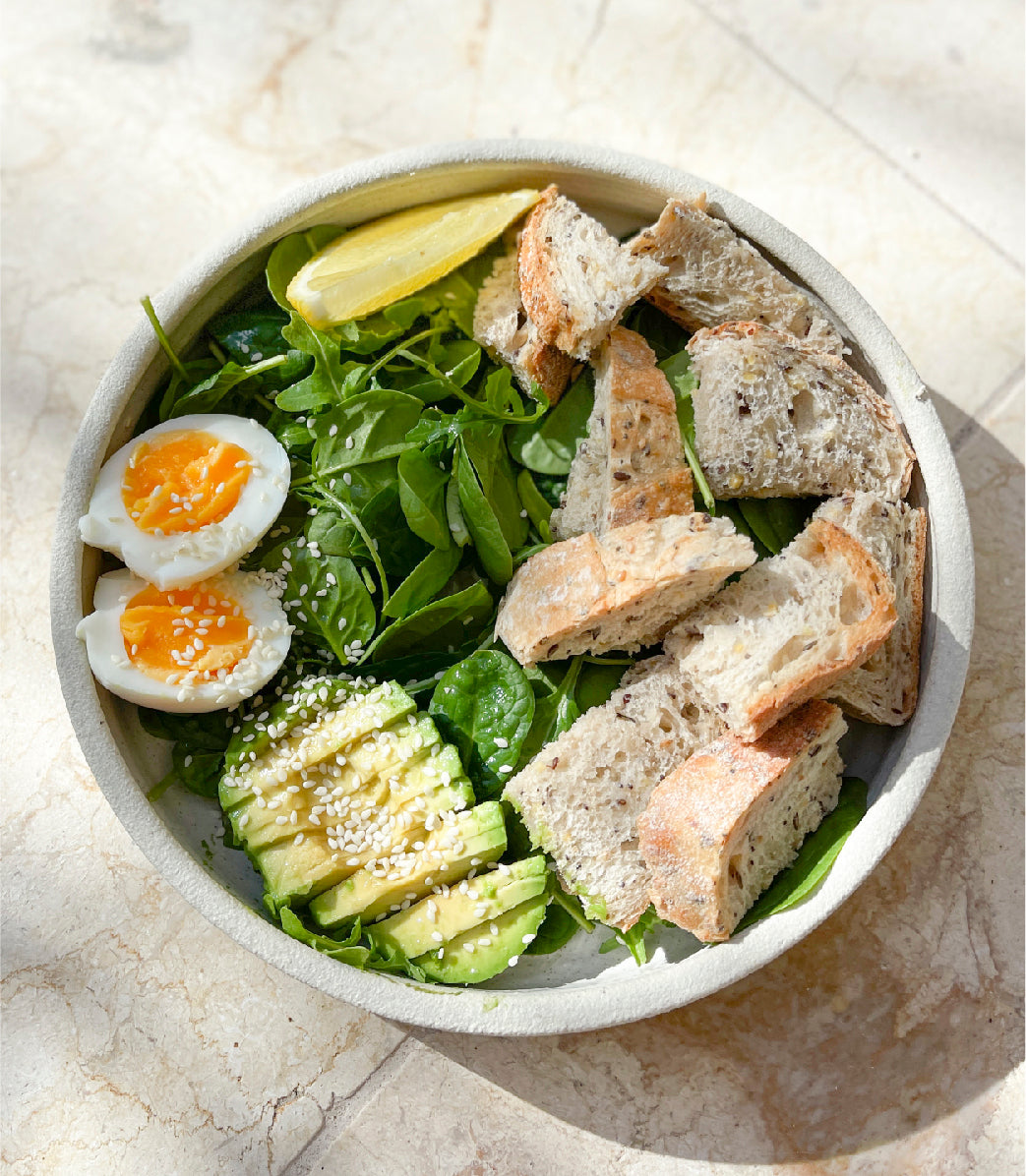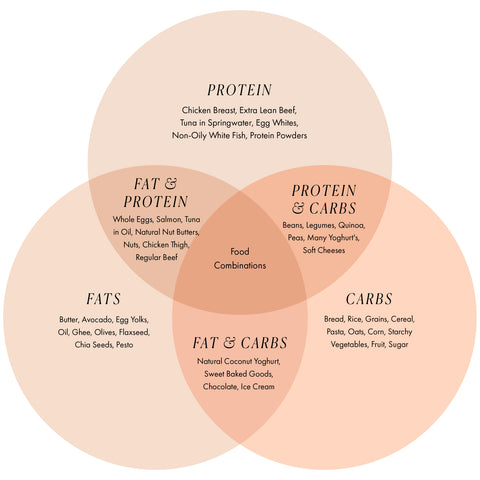Determining Your Macros

Learning about nutrition is just like adding a tool to your toolbox! The more tools, the better you can do the job! This certainly applies to nutrition, too. You can use your knowledge to choose what to fuel your body with! Once you have mastered the basics of nutrition, you are on your way to tracking your macronutrients and implementing flexible dieting!
What are macros?
Macros is a shortened version of the word “macronutrients”. There are 3 macronutrients that primarily make up our calories: protein, carbohydrates and fats. They all provide our body with energy; specifically:
- 1 gram of protein = 4 calories
- 1 gram carbohydrates = 4 calories
- 1 gram of fats = 9 calories
As you can see, protein and carbohydrates provide the same amount of energy - with fats being a little bit higher in calories.
Below is a little cheat sheet to help you work out the macro compositions of common foods.

Why should I learn about macros?
As mentioned before, learning about nutrition just adds that extra tool into your toolbox! By learning the “WHY” to your nutrition, you can confidently tailor it to your goals. Whether that be to lean down/drop body fat, grow muscle or maintain what you have - learning about nutrition will help!
Are all macros equal?
Macros are definitely not created equal! They all provide different nutrition to our body with different tasks:
Protein
Getting enough protein is one of the most important nutritional considerations, especially for active individuals as they have elevated protein needs. Eating enough protein supports muscle protein synthesis, which translates into muscle maintenance and growth.
Protein also has a higher thermic effect of food (TEF) than carbohydrates and fats. It has been estimated that protein’s TEF is around 30%, whereas carbohydrates sit around 5-10%, with fats only contributing 0-3%. Protein’s higher TEF is likely due to slower digestion rate, requiring more energy in the process. This is why a higher protein diet is beneficial for weight loss - it both increases satiety and boosts energy expenditure!
Carbohydrates
Carbohydrates are your body's preferred source of fuel. They break down into glucose (sugar), providing energy for many tissues in the body, such as red blood cells, central nervous system and brain! Carbohydrates are also important for replenishing muscle glycogen storages, providing fuel for training and increasing power outputs.
Fibre is something to note also! Fibre is the leftover indigestible portion carbohydrates that cannot be broken down in our digestive system. It is split into two categories: soluble and insoluble fibre - both having different roles. Soluble fibre slows the emptying process in our stomachs and promotes satiety. It’s contained in foods such as fruits, vegetables, oats, barley and legumes. Insoluble fibre absorbs water to soften the contents of your bowel, as well as support a healthy gut. It’s found in wholegrain breads and cereals, nuts, seeds, wheat bran and the skin of fruit and vegetables.
Sufficient fibre intake is very important for digestion and gut health! Healthy women should aim for 25-30g of fibre per day.
Fats
Fats have multiple important functions in the body, from helping absorb certain vitamins to balancing out hormones and providing essential cushioning to the organs.
A nutritious diet must include sufficient amounts of healthy fats:
- Unsaturated fats, which include polyunsaturated and monounsaturated varieties. These should form the bulk of your fat intake. Sources of polyunsaturated fats include: oily fish, walnuts, hazelnuts and brazil nuts, chia/sunflower seeds, oil spreads (canola/sunflower) etc. Monounsaturated fats can be found in: extra virgin olive oil, avocado, almonds, peanuts, cashew nuts and olive oil spreads etc.
- Saturated fats are important, too - aim to prioritise those coming from wholesome sources, i.e. pure butter or coconut oil. As saturated fats are often abundant in packaged foods and snacks, it’s something to watch out for to maintain reasonable daily consumption.
Fats to avoid as much as possible are trans fats, created by processing the unsaturated fats and significantly altering their structure. This results in trans fats behaving like saturated fats in the body, disrupting many processes and increasing risk of heart disease. Always inspect packaged goods for trans fats, which are usually clearly labelled on the nutrition panel.
So, how do I work out my macros?
First of all, you will need to have a calorie target to work with! If you’ve purchased one of our programs, you will know your calorie target. However, if you haven’t, ideally you will need to get this from a qualified professional such as a Dietitian or an experienced coach. There are many energy expenditure calculators out there, however they may not correctly take into consideration your personal preferences and current relationship with food.
For example, let’s assume a female with a body weight of 60 kg has determined that for her current goals she needs 1700 calories daily.
The first step is working out the protein! For protein, for active individuals a recommended range is between 1.6-2.2g of protein per kg of body weight per day. Let’s say we choose a moderate amount of protein, 2.0g/kg - and we do the calculation shown below!
60kg x 2.0g protein = 120g protein
Therefore 120g protein x 4 calories = 480 calories
1700 calories - 480 calories (from protein) = 1220 calories left
Carbohydrates and fats are interchangeable, but here at MWU we like to use a starting point of 60% remaining calories from carbohydrates and 40% from fats. After you’ve done this last calculation, you will have a basic breakdown of your macronutrients!
60% of 1220 (remaining calories) = 732 calories for carbs
732 ÷ 4 to workout the carbs = 183g (can round to 185 g of carbs for convenience)
You can either work out 40% of 1220 calories or just deduct 732 calories from 1220 calories to get the remaining number of calories for fats.
1220 calories - 732 calories = 488 calories (remaining calories)
488 ÷ 9 = 54g fats
Voila! There you have it! A step by step guide on how you can work out your macros! Here is the macro breakdown:
Food choices - fueling your body correctly
Just because you can hit your macros with chocolate, ice cream and fast food doesn’t mean you should….can you imagine how you would feel after a while? Most probably - lethargic, sluggish, and with some degree of gastrointestinal discomfort due to inadequate fibre intake.
To give your body the proper fuel it needs you still need to give it nourishing wholesome foods from all of the food groups - that is why we preach a balanced approach incorporating lots of nutritious foods while still enjoying the foods you love.
Well, there you have it - a full start to finish guide on understanding and working out your macros! We hope you have learned a lot, and please do not hesitate to reach out if you have any questions remaining.







